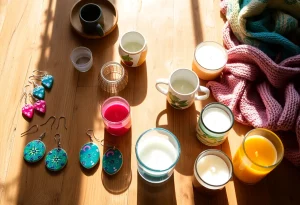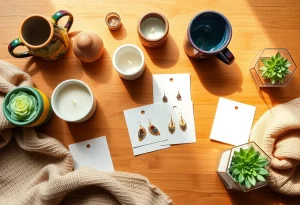Table of Contents
Etsy’s Handmade Marketplace Landscape
Etsy has become the go-to platform for unique, handcrafted goods, boasting over 7.5 million active sellers and 96.3 million active buyers as of 2022. This vibrant marketplace has seen tremendous growth, with gross merchandise sales reaching $13.3 billion in 2021, up 31.2% from the previous year.
The rising popularity of handmade items stems from several factors:
- Increased desire for personalized products
- Growing support for small businesses and artisans
- Emphasis on sustainability and eco-friendly consumption
- Appreciation for unique, one-of-a-kind pieces
Global events have significantly impacted the demand for handmade products on Etsy. During the COVID-19 pandemic, there was a surge in:
- Home decor and furnishings as people spent more time indoors
- Handmade face masks and personal protective equipment
- DIY craft kits and supplies for at-home activities
- Personalized gifts for virtual celebrations
Let’s take a look at some key statistics that highlight Etsy’s growth:
| Metric | 2019 | 2021 | Growth |
|---|---|---|---|
| Active Sellers | 2.7 million | 5.3 million | 96.3% |
| Active Buyers | 46.4 million | 90.1 million | 94.2% |
| Gross Merchandise Sales | $5.0 billion | $13.3 billion | 166% |
Understanding these trends is crucial for sellers looking to tap into Etsy’s thriving marketplace. For those managing multiple sales channels, tools like Marketplace Connect can help streamline operations and keep inventory synced across platforms.
To get a deeper insight into Etsy’s top-selling trends for 2023, check out this informative video:
As we delve into Etsy’s top-selling handmade items, keep in mind that success on the platform often comes from a combination of trend awareness, quality craftsmanship, and effective marketing strategies.
Top 10 Bestselling Handmade Categories on Etsy
Etsy’s handmade marketplace is a treasure trove of unique items. But some categories consistently outshine others when it comes to sales. Let’s dive into the most popular handmade products that keep shoppers coming back for more.
Jewelry and accessories reign supreme on Etsy. From delicate necklaces to statement earrings, these items top the charts year-round. Home decor follows close behind, with personalized touches being a big hit.
Here’s a quick rundown of the top-selling categories:
- Jewelry
- Home decor
- Clothing
- Art and collectibles
- Craft supplies
Interestingly, seasonal trends play a big role in what sells best. During the holidays, personalized ornaments and gift items see a huge spike. Come spring, wedding-related products start flying off the virtual shelves.
Handmade soaps and candles have also seen a surge in popularity. With more people focusing on self-care, these items have become go-to gifts and personal indulgences.
For sellers looking to tap into these hot markets, it’s crucial to keep an eye on trends and adapt quickly. This is where tools like Marketplace Connect can be a game-changer, helping you manage inventory across multiple platforms seamlessly.
Pricing and Profit Margins for Etsy Bestsellers
Pricing handmade items can be tricky. You want to make a profit, but also stay competitive. Let’s break down some pricing strategies for top-selling categories:
- Calculate your costs (materials, time, overhead)
- Research competitor pricing
- Factor in Etsy fees
- Set a fair profit margin
Average price points vary widely depending on the category. Jewelry, for example, can range from $20 for simple pieces to $200+ for more intricate designs. Home decor items often fall in the $30-$100 range.
Factors that influence profit margins include:
- Material costs
- Time investment
- Uniqueness of the item
- Market demand
Balancing competitive pricing with profitability is key. Don’t undervalue your work, but also be mindful of what the market will bear. Regular price testing can help you find that sweet spot.
This video offers some realistic advice for those looking to start an Etsy shop, including tips on pricing and profit margins.
Scaling Your Handmade Business Beyond Etsy
While Etsy is a great starting point, many successful sellers eventually look to expand. Multi-channel selling can open up new opportunities and help grow your business. But it also comes with challenges.
| Benefits | Challenges |
|---|---|
| Increased reach | Inventory management |
| Diversified income | Order tracking |
| Brand growth | Consistent pricing |
Managing inventory across multiple platforms can be a headache. You don’t want to oversell and disappoint customers, or tie up cash in excess stock. This is where tools like Marketplace Connect come in handy. It helps sync your inventory in real-time across different sales channels.
Order management is another key consideration when scaling. Keeping track of orders from multiple sources can quickly become overwhelming. Automating this process can save you time and reduce errors.
Expanding beyond Etsy doesn’t mean abandoning it. Many sellers find success in using Etsy alongside their own website or other marketplaces. The key is finding the right mix that works for your business and your customers.
Remember, scaling takes time and careful planning. Start small, perhaps by adding one new sales channel at a time. Monitor your results closely and be prepared to adjust your strategy as needed.
Leveraging Etsy Trends for Multi-Channel Success
Understanding Etsy’s top-selling handmade items offers valuable insights for sellers looking to expand their reach across multiple e-commerce platforms. By analyzing these trends, we can uncover strategies to boost sales and brand presence beyond just Etsy.
Here are key ways to leverage Etsy’s bestsellers for multi-channel success:
- Adapt popular designs for different marketplaces
- Maintain consistent branding across all channels
- Use trend data to inform product development
- Tailor marketing strategies based on platform-specific audiences
One crucial aspect of multi-channel selling is maintaining inventory accuracy. With items flying off the shelves across different platforms, it’s essential to have a system in place that can handle real-time updates. This is where tools like Marketplace Connect come in handy, offering seamless inventory syncing across channels.
Let’s break down the benefits of applying Etsy insights to your broader e-commerce strategy:
- Increased market reach
- Diversified revenue streams
- Enhanced brand visibility
- Improved product development based on cross-platform data
While expanding to multiple channels can seem daunting, the right tools can simplify the process. Automated order management and inventory syncing allow you to focus on scaling your business rather than getting bogged down in manual updates.
Remember, success on Etsy doesn’t guarantee success elsewhere. Each platform has its unique audience and requirements. However, by applying the lessons learned from Etsy’s top sellers and utilizing multi-channel management tools, you can create a robust, diversified e-commerce presence that reaches customers wherever they prefer to shop.
Wrap-up
Etsy’s handmade marketplace is a goldmine for creative entrepreneurs. We’ve explored some of the top-selling categories, from jewelry to home decor. The key takeaway? There’s room for everyone, but standing out takes work.
Success on Etsy isn’t just about making great products. It’s about smart pricing, eye-catching photos, and connecting with your audience. And don’t forget – Etsy is just one piece of the puzzle. Many sellers find that branching out to other platforms can really boost their business.
Managing multiple sales channels can be tricky, though. That’s where tools like Marketplace Connect come in handy. They help keep everything in sync, so you can focus on what you do best – creating.
Ready to take your handmade business to the next level? The world of e-commerce is waiting. With the right strategy and tools, your creations could be the next big thing on Etsy and beyond.
Common Questions About Selling Handmade Items Online
How do I start selling on Etsy?
Starting on Etsy is straightforward. First, create an account and set up your shop. Then, add product listings with clear photos and descriptions. Make sure to research Etsy’s policies and best practices. Many sellers find success by starting with a small selection of items and expanding as they learn the platform.
What are the best ways to price handmade items?
Pricing handmade items requires balancing costs, time, and market demand. Calculate your materials and labor costs, then add a profit margin. Research similar items on Etsy to gauge competitive pricing. Don’t undervalue your work – remember that handmade items often command higher prices due to their uniqueness and quality.
How can I manage inventory across multiple sales channels?
Managing inventory across channels can be challenging. Using a multi-channel management tool can help keep everything in sync. For Shopify users, Marketplace Connect offers real-time inventory updates across various platforms, reducing the risk of overselling and simplifying order management.
What are some tips for taking great product photos?
Good product photos are crucial for online sales. Use natural lighting when possible and a simple, clean background. Take multiple angles of each item. Consider lifestyle shots to show the product in use. Editing software can help enhance images, but keep them realistic to avoid customer disappointment.
How often should I add new items to my Etsy shop?
Regularly adding new items keeps your shop fresh and can boost visibility. Aim to add new products or variations weekly or bi-weekly if possible. This doesn’t always mean creating entirely new items – you can also update existing products with new colors or styles.
What are some effective ways to market my handmade items?
Marketing handmade items often relies on showcasing their uniqueness. Use social media platforms like Instagram and Pinterest to share your process and finished products. Engage with your audience by responding to comments and messages. Consider collaborating with influencers or bloggers in your niche. Email marketing can also be effective for keeping customers informed about new products and sales.





